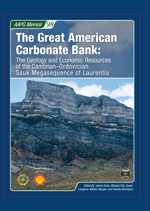Great American carbonate bank
| The great American carbonate bank: The geology and economic resources of the Cambrian-Ordovician Sauk megasequence of Laurentia | |

| |
| Series | Memoir 98 |
|---|---|
| Chapter | Introduction |
| Author | R. D. Fritz, W, A. Morgan, S. Longacre, J. R. Derby, C. A. Sternbach |
| Link | Web page |
| PDF file (requires access) | |
| Store | AAPG Store |
Laurentia (North American Craton) is a large continental craton, which forms the ancient geological core of the North American continent.

The great American carbonate bank (GACB) refers to a system of carbonates and related siliciclastics that were deposited on and around the Laurentian continent during the Cambrian, Early Ordovician, and earliest Middle Ordovician. This laterally continuous and diverse sequence has been assigned different sets of formation and group names across the GACB, such as Arbuckle, Beekmantown, Bonanza King, Deadwood, Ellenburger, El Paso, Knox, Prairie du Chien, and Potsdam (to name just a few of the more widely used), but characteristic lithofacies and fauna that are found throughout North America, Greenland, northwestern Scotland, Svalbard, and the pre-Cordillera of Argentina are observed.
Fundamental to our understanding of the components of the GACB is the biostratigraphy that ties the disparate parts into a cohesive whole. Biostratigraphic zonation has advanced considerably since the days when Sloss et al.[2] coined the term Sauk sequence and Palmer[3] subdivided the Sauk into three subdivisions. It is now possible to identify more than 20 biostratigraphic zones within the Sauk succession for the Laurentian continent (with finer subdivision possible on a more local basis) using mostly trilobites and conodonts.
Great American carbonate bank reservoirs in the United States and Canada have produced from more than 28,000 oil and gas wells in approximately 3650 fields. These fields are distributed across 30 producing regions, with heavy concentration of production centered in the states of Texas, Oklahoma, Kansas, Nebraska, New Mexico, Michigan, Ohio, and Kentucky. Great American carbonate bank reservoirs have yielded 4.22 billion bbl of oil and 2198 tcf of gas. As of 2012, translating that gas into oil equivalent, GACB reservoirs have produced a combined 7.88 billion barrels of oil equivalent (BOE); more than half of this (57%) is oil. As of 2007, GACB reservoirs produced at rates of approximately 16 MMBO and 160 bcf/year. Hydrocarbon production occurs primarily at or near the Sauk-Tippecanoe unconformity, in association with source rock and seal; however, production can occur in strata many hundreds of feet below this unconformity.
In addition to being rich with petroleum products and economic minerals, the GACB also has value for water use and injection and is used for road material in many areas of North America. Because of its scientific and economic value, thousands of feet of core and related rock and reservoir information is available for GACB carbonates.
See also[edit]
- Great American carbonate bank, paleogeography
- Great American carbonate bank, biostratigraphy
- Great American carbonate bank, chronostratigraphy
- Great American carbonate bank, sequence stratigraphy
References[edit]
- ↑ USGS Geology in the Parks, , http://geomaps.wr.usgs.gov/parks/pltec/nacraton.html
- ↑ Sloss, L. L., W. C. Krumbein, and E. C. Daples, 1949, Integrated facies analysis, in C. R. Longwell, ed., Sedimentary facies in geologic history: Geological Society of America Memoir 39, p. 91–124.
- ↑ Palmer, A. R., 1981, Subdivision of the Sauk sequence, in M. E. Taylor, ed., Short papers for the 2nd International Symposium on the Cambrian System: U.S. Geological Survey Open File Report 81-743, p. 160–162.